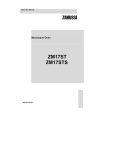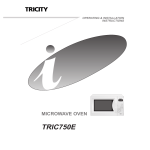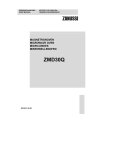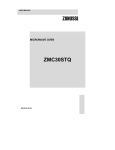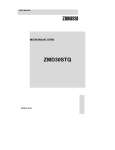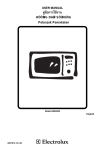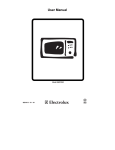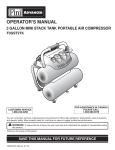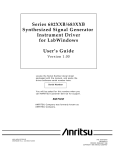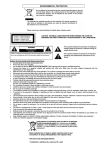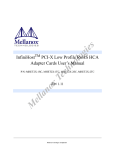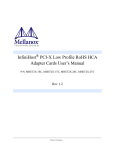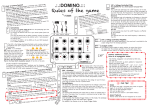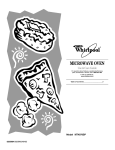Download Zanussi ZMU17MXL User's Manual
Transcript
t ZMU17MXL Contents Before using your microwave oven 4 Safety instructions – Utensil safety – Testing suitability of cookware – Food safety – Oven utensils and accessories guide Technical data 4 4 5 5 6 6 Getting Started – Unpacking Installation – Connecting to the mains – Electrical connections 7 7 7 7 7 How to operate your microwave oven – Name and function of parts – Turntable Installation – Control panel – Microwave Cooking – Microwave Power Setting Guide – Defrosting instructions using 200W – Microwave Hints – Care and cleaning – Cleaning the accessories (turntable and support) – Cleaning the interior – Cleaning the exterior 8 8 8 9 10 10 11 12 13 13 13 13 Service and Spare Parts 14 Guarantee conditions 15 Building In Instructions 16 3 English t ZMU17MXL English 'SRKVEXYPEXMSRWSRXLITYVGLEWISJ]SYVRI[1MGVS[EZI3ZIR Thank you for having chosen a Zanussi product. We are convinced that you will find your new microwave oven very useful and that it will be of great help to you. As with all new kitchen appliances, it will take some time to learn all the new functions and features, but with time, this oven will become indispensable to you. Before using your Microwave Oven Read through the instruction manual carefully and ensure that you follow the recommendations given, these instructions have been prepared so that you get the best from your new Zanussi Microwave Oven. It is important that this instruction book is retained with the appliance for future reference. Should the appliance be sold or transferred to another owner, or if you move house and leave the appliance, always ensure that the book is supplied with the appliance so that the new owner can be acquainted with the functioning of the appliance and the relevant warnings. Safety Instructions • • • • • • • • • • The built-in safety interlock switches prevent the microwave oven from operating when the door is open. Do not tamper with them, or attempt to operate the oven with the door open as open door operation can result in exposure to microwave energy. Do not allow food spills or cleaner residue to accumulate on door sealing surfaces. See the Cleaning and Care section for cleaning instructions. Do not operate the oven if it is damaged until it has been repaired by qualified service personnel. It is particularly important that the oven door closes properly and that there is no damage to the: (1) door (warped), (2) hinges and latches (broken or insecure), (3) door seals and sealing surface. Under no circumstances should you attempt to repair the appliance yourself. Repairs carried out by inexperienced persons may cause injury or serious malfunctioning. Contact your local Service Force Centre. Do not remove the outer case, door or control panel at any time. Doing so may cause exposure to extremely high voltage. Install or locate this oven only in accordance with “INSTALLATION INSTRUCTIONS” found in this manual. Use the appliance for its intended use as described in this manual. Do not use corrosive chemicals in this appliance. This type of oven is specifically designed to heat, cook, or defrost food. It is not designed for industrial or laboratory use neither for commercial use as this will invalidate the guarantee. • • • • Do not operate the oven empty. If food or water is not present to absorb the microwave energy, the magnetron tube can be damaged. Close supervision is necessary when the oven is used by children. Do not store this appliance outdoors. Do not use this product near water. Do not attempt to dry clothing or newspapers in the microwave oven. These items can ignite. Do not use the cavity for storage purposes. Do not leave paper products, cooking utensils, or food in the cavity when not in use. Utensil safety Most glass, glass ceramic and heat-resistant glassware utensils are excellent for use in the microwave oven. Although microwave energy will not heat most glass and ceramic items, these utensils can become hot as heat transfers from the food to the container. The use of oven gloves to remove dishes is recommended. 4 t ZMU17MXL Testing suitability of cookware • • • • • • • English Food safety • Place the cookware in the cavity along with a glass half full of water. Heat on 600 W (100%) for one minute. If the cookware feels hot, you should not use it. If it is just slightly warm, you can use it for reheating but not for cooking. If the dish is room temperature, it is suitable for microwave cooking. Paper napkins, wax paper, paper towels, plates, cups, cartons, freezer wrap and cardboard are great convenience utensils. Always be sure containers are filled with food to absorb energy and thus avoid the possibility of overheating. Many plastic dishes, cups, freezer containers and plastic wraps may be used in the microwave oven. Follow manufacturer’s instructions when using plastics in the oven. Avoid using plastic utensils with foods that have high fat or sugar content since these foods reach high temperatures and could melt some plastics. Do not leave oven unattended, and look at it from time to time when heating or cooking food in plastic, paper or other combustible containers. If smoke is observed, keep door closed, switch the oven off or disconnect oven until smoke stops. Metal utensils and utensils with metallic trim should not be used in the microwave oven, unless specifically recommended for microwave use. Containers with restricted openings, such as bottles, should not be used for microwave cooking. Use caution when removing a lid or cover from a dish to avoid steam burns. • • • Do not heat food in a can in the microwave oven. Always remove the food to a suitable container. Deep fat frying should not be done in the microwave oven, because the fat temperature cannot be controlled, hazardous situations can result. Popcorn may be prepared in the microwave oven, but only in special packages or utensils designed specifically for this purpose. This cooking operation should never be un-attended. Pierce foods with non-porous skins or membranes to prevent steam build-up and bursting. Apples, potatoes, chicken livers, and egg yolks are examples of items that should be pierced. WARNING: When heating liquids, e.g. soups, sauces and beverages in your microwave oven, overheating the liquid beyond boiling point can occur without evidence of bubbling. This could result in a sudden boil over of the hot liquid. To prevent this possibility the following steps should be taken: 1. Avoid using straight-sided containers with narrow necks. 2. Do not overheat. 3. Stir the liquid before placing the container in the oven and again halfway through the heating time. 4. After heating, allow to stand in the oven for a short time, stirring again before carefully removing the container. • Some products such as whole eggs and sealed containers – for example, closed glass jars – may explode and should not be heated in this oven. Occasionally, poached eggs may explode during cooking. Always pierce the yolk, then cover and allow the standing time of one minute before removing cover. NOTE: • Do not force the turntable to rotate by hand. This may cause malfunctioning. • Arcing in the oven during microwave operation usually occurs from use of metallic utensils. Continuous arcing, however, can damage the unit. Stop the programme and check the utensil. • Care should be taken not to obstruct any air vents located on the top, rear, side and bottom of the oven. Do not use this oven for commercial purposes. This oven is made for domestic use only. Keep these instructions 5 t ZMU17MXL English Oven utensils and accessories guide A variety of Utensils and Materials may be used for cooking in your microwave oven. For your safety and to prevent damaging utensils and your oven choose, appropriate utensils and materials for each cooking method. The list below is a general guide. Material Ceramic & Glass China Pottery Plastic Utensils Corning ware Heat resistant glass ware Glass ware with metal decoration Lead crystal glass Without metal decoration Microwave oven heat-proof wear Plastic wrap Metal baking pan Aluminium foil* Cups, plates, towels Metal Paper Waxed Paper Wood Accessories Turntable Turntable support Microwave Cooking YES YES NO NO YES YES YES YES NO YES YES YES NO YES YES YES: Utensils and accessories to use NO: Utensils and accessories to avoid *NOTE: Use aluminium foil only for shielding purposes, overuse may cause arcing. Technical data 3ZIVEPPHMQIRWMSR ;IMKLXOK ;MHXLQQ :SPYQI0MXVI (ITXLQQ ,IMKLXQQ 4S[IVWSYVGI:,^ 'EZMX]HMQIRWMSR *YWI% ;MHXLQQ 4S[IVGSRWYQTXMSR; (ITXLQQ ,IMKLXQQ 4S[IVSYXTYX; 6 t ZMU17MXL English GETTING STARTED Unpacking Connecting to the mains N.B. When you unpack the oven, check that the product is free from damage. Damage or any missing parts must be reported immediately to the retailer. The oven, parts of the oven or the accessories may be wrapped by a protection foil. If so, you must remove this foil before using the oven. Do not leave packing material so that small children can play with it. This can be hazardous. The oven is delivered with the power cord and a plug for 230V, 50Hz, earthed socket outlet. Earth protection minimises the risks should a short-circuit occur. Check to ensure the voltage of the oven matches the supply. N.B. If the oven is connected to the socket via an extension cord, make sure the cord is earthed. WARNING! This appliance must not be used on a non-earth protected power supply. Installation Contact an electrician if you are uncertain regarding electrical connection of the oven or provision of earth protection of the supply. 1. Remove any promotion label from the door. 2. Install the oven on a flat, level surface. The surface must be strong enough to safely bear the weight (10 kg) of the oven, and the contents. To avoid the possibility of causing vibration or noise the oven must be in a stable position. 3. Keep the oven away from heat and water. Exposure to heat and water can lower oven efficiency and lead to malfunctioning, so be sure to install the oven away from heat and water sources. 4. Do not block air vents on the top and the sides of the cabinet and also do not place any articles on the top of the oven. If air vents are blocked during operation, the oven may overheat, and this may lead to malfunctioning. Hot air escapes from the vents, so be sure not to obstruct it or let curtains come between the oven and the rear wall. 5. Place the oven as far away from radios and TV’s as possible. This oven does conform to EEC requirements* of radio interference suppression, but some interference may occur if it is placed too close to a radio or TV, so keep them as far apart as possible. 6. If positioned in a corner, leave a gap of at least 5,0 cm from the walls to meet ventilation demands. This appliance must be earthed. If this appliance is fitted with a non-rewireable plug for which your socket is unsuitable, the plug should be cut off and the appropriate plug fitted. If it is necessary to change the fuse in a non-rewireable plug, the fuse cover must be refitted. If the fuse cover is lost or damaged, the plug must not be used until a replacement is obtained. Electrical connections This appliance come fitted with a standard 2 pin moulded euro plug WARNING! THIS APPLIANCE MUST BE EARTHED. The manufacturer declines any liability should this safety measure not be observed. • Important! The oven can be placed almost anywhere in the kitchen. Make sure the oven is placed on a flat, level surface and that vents as well as the surface underneath the oven are not blocked (for sufficient ventilation). If the plug that is fitted to your appliance is not suitable for your socket outlet, it must be cut off and the appropriate plug fitted. Remove the fuse from the cut off plug. The cut off plug should then be disposed of to prevent the hazard of shocks in case it should be plugged into a 13 Amp socket in another part of your home. * This appliance conforms to the requirements of EEC Radio Interference Directive 87/308/EEC. 7 t ZMU17MXL English How to operate your microwave oven 1 3 2 5 6 4 4 7 8 Name and function of parts Turntable Installation 1. Cooking compartment. Wipe the compartment clean after using the oven. 2. Viewing window. Food can be checked while the microwave oven is in operation. 3. Oven door. The door must always be firmly closed while cooking. 4. Latch hook and safety interlock system. 5. Control panel. 6. Drive shaft for turntable 7. Turntable. Made of special heat-resistant glass. Food in a suitable container is placed on this tray for cooking. Do not use the oven without the turntable. 8. Turntable support. Place the support on the floor of the cooking chamber to support the turntable. 1. Place the turntable support on the cavity Bottom. 2. Place the turntable on top of the turntable support as shown in the diagram. Make sure that turntable hub is securely locked in the turntable shaft. Never place the turntable upside down. • Both turntable and turntable support must always be used during cooking. • All food and containers of food are always placed on this turntable for cooking. • This turntable rotates clockwise and anticlockwise; this is normal. Turntable Roller rest Turntable Shaft 8 t ZMU17MXL English CONTROL PANEL 1. Timer Set for desired cooking time. Cooking will start. All clockwork timers will operate more accurately if wound past the desired time first, and then back. 2. Power Selector Adjust this knob to select the correct power level for your food. 9 t ZMU17MXL English MICROWAVE COOKING 1. Open the door, place the food on the turntable. Close the door. 2. Set the Power Selector to the desired power level.(See table below.) 3. Set the Timer to the desired time. The oven begins cooking. When cooking for less than 2 minutes, turn the timer for a longer period and than return to the desired time. To turn off the oven during cooking, simply turn the Timer to 0. Note: After use, be sure to return the Timer to 0, or the oven will continue to operate. Example: To cook at 540W for 15 minutes 1. Turn the power selector to 450W. 2. Turn the timer to 15 3. The Oven will automatically start cooking for 15 minutes at 450W Microwave Power setting Guide Power Setting 100W 200W 300W 450W 600W Suggested use Simmer; Completing the cooking cycle of some pot roasts. Casseroles and stews. Baked custards or cheesecakes. Defrost; Thawing frozen foods. Medium; Faster defrosting and reheating for casseroles and stews. Baking cakes and sponge puddings Reheat; Reheating pre-cooked foods. Roasting joints of meat and poultry. Max Power; Boiling or reheating liquids. Cooking vegetables. Preheating a browning dish. 10 t ZMU17MXL Recommendations for Defrosting (using 200W English ) Some foods such as bread and fruit, can successfully be thawed manually by using the power setting. FOOD (200W) STANDING TIME 8–10 min. 10–15 min. 10–13 min. 10 min 45–60 sec. 45–60 sec. 1–11/2 min. 5 min. 5 min. 5 min. Remove from packaging, place on plate. 9–11 min. 15–30 min. Remove from packaging, place on plate. 9–11 min. 15–30 min. Remove from packaging, place on plate. 7– 9 min. 15–30 min. Remove from packaging, place on plate. 7– 9 min. 15–30 min. If foil wrapped, remove from wrapper and place on a plate 3– 4 min. 5–10 min. Place in a single layer in a shallow dish. 5– 6 min. 5–10 min. 7– 8 min. 5–10 min. 7– 8 min 5–10 min. PREPARATION Bread Small loaf Sliced large loaf 2 slices 1 bread roll 2 bread rolls Cakes and Pastry Gateau 450g/1 lb Cheesecake 450g/1 lb Pie (cooked) 450g/1 lb Pastry 450g/1 lb Butter 250g/8.8 oz (1 packet) Fruit 225g/8 oz Soft berry fruits 450g/1 lb Soft berry fruits Plated meal 400g/14 oz Place on microwave-proof rack or kitchen paper. Turn over halfway through defrosting time. Place on microwave-proof rack or kitchen paper. Turn over halfway through defrosting time. Place on kitchen paper. Place on kitchen paper. Place on kitchen paper. Place in a single layer in a shallow dish. Cover with a plate or non P.V.C. cling film. To reheat, microwave on 100% (600W)for 3–4 minutes. Vegetables It is not necessary to defrost vegetables before cooking. All vegetables can be thawed and cooked on 100% (600W) 11 t ZMU17MXL Microwave Hints • • • • • • • • • • • • • • • • • English Microwave Tips Always keep the oven clean – avoid spill-overs and do not forget to clean under the glass tray and the inside of the door. Preferably use round or oval casseroles with a lid when cooking in your microwave oven. Do not use metal or metal decorated casseroles. Certain plastic materials can melt and be warped by hot food. Cover the food when cooking. Use a glass lid, a plate or grease proof paper. Pastry, bread and the like can be defrosted directly in a bread basket or on a paper towel. If frozen food is heated in its packaging, the packaging should be opened. Packaging containing metal or metal decoration must not be used unless specifically recommended for use in the microwave. Remove metal clips and wire ties. Smaller pieces of aluminium foil can be used to cover parts that easily over cook such as chicken legs. Food with peel or skin should be pierced with a fork – e.g. potatoes and sausages. Do not boil eggs in the microwave oven as they can explode. Put large, thick pieces close to the edge of the casserole and try to cut the food in to even sized pieces. Always place the food in the centre of the oven. The food will be evenly cooked if you stir or turn it a few times. Always set a shorter cooking time than indicated in your recipe to avoid over cooking. The larger the amount of food the longer it takes. Use little or no water for vegetables. Use less salt and spices than for ‘normal’ cooking. Season afterwards. Allow a few minutes ‘standing’ time after the oven has switched off to ensure complete and even cooking results. Always ensure food is piping hot throughout before serving. Use pot holders or gloves when taking dishes and food from the oven. 12 • Softening Honey If you have a jar of honey which has crystallised, remove lid and place the jar in the oven, microwave on medium power for 2 minutes. • Melting Chocolate Break 100g of chocolate into squares, place in a bowl and heat on high power for 1-2 minutes and stir well. • Softening or Melting Butter Melting takes a few seconds on high power. Softening is best done more gently on low power. • Freshen or Warm Bread Use medium power for few seconds. • Peeling Garlic easily Heat 3 or 4 cloves of garlic on high power for 15 seconds. Squeeze at one end until the clove pops out. • Fruit Juice Citrus fruits will yield more juice if they are heated on high power for 15 seconds before squeezing. • Cooking Porridge Porridge is easily cooked in the serving dish with no sticky pan to wash. Follow food manufacturers’ recommendations. t ZMU17MXL English Care and cleaning The oven must always be clean. Residue of food from spillovers or spatters will attract microwave energy causing it to burn on. This could reduce the efficiency of the oven and may cause bad odours. Do not attempt to tamper with or make any adjustments or repairs to any part of the oven. Repairs should only be done by a qualified service technician. Be sure the oven is disconnected from the electricity supply before cleaning. Cleaning the accessories (turntable and support) Clean them with mild detergent after removing them from the cavity. The turntable support should be carefully handled. CAUTION: The inside of the oven and turntable get very hot, so do not touch them immediately after use. Cleaning the interior Always keep the inside of the oven clean. Wipe up spill-overs and food spatters immediately. Deposits that are allowed to remain on the oven walls, door seal and door surface will absorb microwave energy, reduce the efficiency of the oven, and possibly damage the oven interior. Use mild, liquid detergent, warm water and a soft, clean cloth to remove deposits. NEVER USE ABRASIVE CLEANERS, COMMERCIAL OVEN CLEANERS OR STEEL WOOL PADS ON ANY PART OF THE MICROWAVE OVEN. To loosen difficult deposits, boil a cup of water in the microwave oven for 2 or 3 minutes. NEVER USE A KNIFE OR ANY UTENSIL TO REMOVE DEPOSITS FROM OVEN SURFACES. To remove odours from the oven interior, boil a cup of water plus 2 tablespoons of lemon juice for 5 minutes. Cleaning the exterior Open the oven door when cleaning the control panel. This will prevent the oven from being turned on accidentally. You should clean outside surfaces of the oven with mild liquid detergent and water followed by a wiping with clear water to remove any excess detergent. Dry with a soft cloth. Spray-on window cleaners or all purpose spray-on kitchen cleaners can also be used. Never use abrasive cleaners, scouring pads or harsh chemicals on outside surfaces of your oven. To prevent damage to the working parts, do not allow water to seep into ventilation openings. 13 t ZMU17MXL English After-sales service and spare parts If the appliance does not work correctly, carry out the following checks first before contacting the local After-Sales Service Centre. If the oven does not start: • Check that the appliance is connected to the mains. • Check that the plug is pushed in properly. • If appropriate, replace the fuse in the plug by another of the same rating and check that the plug is wired correctly. • Check that any switch, at the wall socket or elsewhere in the circuit, is ON. • Check that the wall socket is working by plugging in something else that you know is working. • Check the fuse in the fuse-box. If the microwaves are not operating: • The child security feature might have been set (available on some models) • Check that the controls have been set correctly. • Check the adjustments/procedures by referring to the instruction manual. • Check that the door is closed properly. (If particles of food or other things remain stuck in the doorway, the door will not close correctly and the microwave oven will not operate.) • Check that the Start button is activated. If the oven still does not work properly after the above checks, contact the local Zanussi After-Sales Service Centre. The address can be found on the following pages of this user guide. IMPORTANT : If you call out a technician for one of the above faults or to repair a fault caused by incorrect installation or operation, you will be charged for this call-out even if the appliance is still under guarantee. When you make your call to the After-Sales Service Centre, you will be asked for the following information: 1. Your name, address and postcode 2. Your telephone number 3. Clear and concise details about the fault 4. The model number 5. The serial number 6. The purchase date We advise you to write down the information below so that you will have the details to hand: Model number: ZMU17MXL Serial number: Purchase date: If your appliance is still under guarantee, you must be sure that the necessary checks have been made, because a technician call-out charge will be levied if the problem is not mechanical or electrical. Please note that your proof of purchase will be required for any call-out made during the guarantee period. Spare parts Spare parts can be purchased through your After-Sales Service Centre. Customer service For all general enquiries about your Zanussi appliance or for other information on Zanussi products, contact our Customer Service by mail or by telephone. 14 t ZMU17MXL English GUARANTEE CONDITIONS Zanussi offer the following guarantee to the first purchaser of this appliance: 1. The guarantee is valid for 24 months commencing when the appliance is handed over to the first retail purchaser, which must be verified by purchase invoice or similar documentation. The guarantee does not cover commercial use. 2. The guarantee covers all parts or components which fail due to faulty workmanship or faulty material. The guarantee does not cover appliances where defects or poor performance are due to misuse, accidental damage, neglect, faulty installation, unauthorised modification or attempted repair, commercial use or failure to observe requirements and recommendations set out in the instruction book. This guarantee does not cover such parts as light bulbs, removable glassware, or plastic. 3. Should guarantee repairs be necessary the purchaser must inform the nearest customer service office (ZANUSSI’s service or authorised agent). ZANUSSI reserves the right to stipulate the place of repair (i.e. the customer’s home, place of installation or ZANUSSI workshop). 4. The guarantee or free replacement includes both labour and materials. 5. Repairs carried out under guarantee do not extend the guarantee period for the appliance. Parts removed during guarantee repairs become the property of ZANUSSI. 6. The Purchaser’s statutory rights are not affected by this guarantee. European Guarantee If you should move to another country within Europe then your guarantee moves with you to your new home subject to the following qualifications: • The guarantee starts from the date you first purchased your product • The guarantee is for the same period and to the same extent for labour and parts as exists in the new country of use for this brand or range of products • This guarantee relates to you and cannot be transferred to another user • Your new home is within the European Community (EC) or European Free Trade Area • The product is installed and used in accordance with our instructions and is only used domestically, i.e. a normal household • The product is installed taking into account regulations in your new country 15 t ZMU17MXL English Building In Instructions Main requirements for the cabinet under which the microwave is to be attached: • • • • • • • • Thickness of the floor of the cabinet > 16mm. Recommended width of cabinet: 500 - 600 mm Depth of cabinet: min. 350 mm When the cabinet is fully loaded (crockery plus microwave), the floor of the cabinet must not sag by more than 5 mm / m. There must be no splits or other damage to the cabinet. The wall mounting for the overhead cabinet must be strong and firmly secured to the wall with at least 2 screws. The appliance cannot be fitted below an overhead cabinet that has a strip light. In the case of self-assembly furniture, veneers or plastic coatings must be attached with heat-resistant O adhesive (over 75 C). If the veneers, plastic coatings or adhesives do not satisfy this requirement, the coating may become distorted or peel off. • Important : do not fit the appliance above a cooker. • Adjacent tall units must be at least 10 mm away. 16 t ZMU17MXL English Building In Instructions • The earthed socket must be easily accessible. Ideally it should be located underneath the cabinet to which the microwave is to be attached. The mains cable must not touch the back of the appliance. If the socket is not accessible, a device must be fitted when the appliance is installed allowing all pins of the plug to be disconnected from the mains with a contact gap of at least 3 mm. Suitable separating devices would be excess current switches, safety fuses and magnetic contactors. The attachment kit consists of: (A) 4 fixing screws (ø 5 x 35 mm for a cabinet floor thickness of 10 23 mm) 4 washers (ø ca.25 mm) 4 washers (ø ca.11 mm) Drilling template (B) (C) (D) Tools required • • • • • • • Pencil Ruler/measuring tape Adhesive tape Drill Drill bit (ø 5.5 mm) Phillips screwdriver Information on installing the microwave Important : The length of the screws is designed for use where the thickness of the floor of the cabinet is 10 - 23 mm. Where the thickness is greater or less than this, the fixing will not be sufficiently solid. 17 t ZMU17MXL English Building In Instructions 1. Remove the contents of the cabinet and adjacent cabinets. 2. Mount the cabinet on the wall, check that it is solid and measure it. Check the location of mains sockets. 3. The holes may be bored from inside the cabinet or from the underside of the cabinet. Drilling inside the cabinet: Mark the holes inside the cabinet according to the sketch. The distance a from the edge of the carcass depends on the thickness of the front of the cabinet d. Select a value for a depending on the thickness of the front of your cabinet, such that the fronts of the microwave and of the cabinet are aligned. t d 16 19 22 d a 79 76 73 mm mm mm 5.5 mm ø 18 ZMU17MXL a t English Building In Instructions Drilling on the underside of the cabinet Using the drilling template, choose the position of the microwave on the underside of the cabinet. (Position the front edge of the microwave door so that it is aligned with the front of the cabinet.) Secure the drilling template with the help of adhesive tape. Use a sharp pencil to transfer the markings for drilling. 4. Drill holes using a 5.5 mm drill bit. Remove drilling dust. 5. Remove the filler plugs on the top of the microwave. 6. Put the microwave in position under the cabinet, possibly with the assistance of another person. Secure from the inside of the cabinet using the screws and the two washers. Tighten the screws equally. 7. Do not connect the mains plug to the earthed socket until the microwave is completely firm. a 19

















